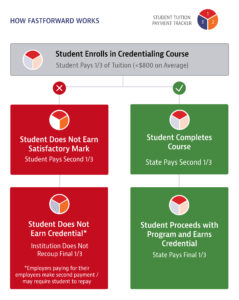Key Highlights
Challenges
Virginia faced a major workforce gap, with 2.6 million jobs requiring “middle skills” — more than a high school diploma but less than a four-year degree. Yet fewer than half of workers in the state had the training to fill them, and many couldn’t afford the cost of credentialing programs.
At the same time, community colleges in the state were paid based on enrollment rather than outcomes, creating little incentive to ensure students completed their programs or earned their credentials.
Opportunities
FastForwardVA, a program of the Virginia Community College System (VCCS), enables risk sharing among students, VCCS, and employers for short-term programs offering a variety of credentials.
VCCS receives payments in chunks from the student upon enrollment, from the state when the student completes the course, and from the state if the student earns the credential. This one-third/one-third/one-third program design creates incentives for Virginia’s community colleges to focus on helping students complete their programs.
Nondegree training courses designed to deliver in-demand workforce credentials training have opened doors to opportunity for underemployed Virginians, specifically adults in their 30s with dependents and people from marginalized backgrounds who receive public benefits. While expanding economic mobility for those traditionally left out of the workforce, FastForwardVA also meets the needs of businesses eager to employ this pipeline of new talent.

Findings and Next Steps
- FastForwardVA enjoys significant support from policymakers because, in addition to increased rates of class and credential completion, graduates of the program are earning higher wages.
- Other states and institutions can replicate FastForwardVA’s success if they adopt key learnings from Virginia: focusing on accountability by making training providers’ revenue conditional upon both completion and attainment, adding state financial support for noncredit or short-term programs, and connecting would-be workers with in-demand jobs.

